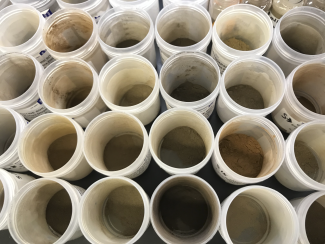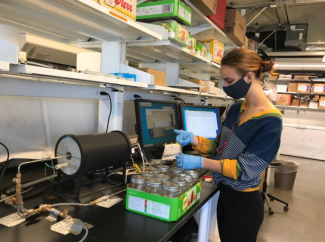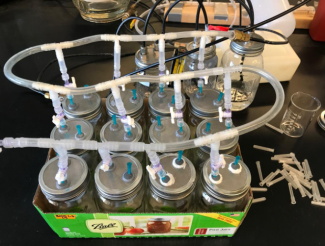Case Study
Getting More Dirt on Soil Organic Matter
October 21, 2020
A new study published in Nature Geoscience digs deep into the chemical composition of soil organic matter in ecosystems across the U.S. Led by Drs. Steven Hall and Chenglong Ye of Iowa State University and co-authored by NEON Research Scientist Samantha Weintraub, the study uses soil from NEON field sites across the continent to look for insights into how ecosystem variables impact the formation and composition of SOM.
Digging into the Composition of SOM
Soil Organic Matter, or SOM, is a measure of the total amount of organic material in the soil. This is the portion of soil that is made up of living or once-living things, including living and dead microbes, decomposing plant and animal matter, and charred carbon from burned organic materials. SOM is directly related to soil productivity and carbon storage. Understanding how SOM forms and what it is made up of in different soil types and ecosystems may help us better predict what kinds of ecosystem services the soil in an area can provide, such as agricultural output.
Soils in different ecosystems vary substantially both in the total amount of organic material they contain and in the type and origin of the organic compounds. The study team wanted to look at how the composition of SOM varies among different ecosystems and soil types. To do this, they looked at the chemical composition of carbon in soil gathered from 42 sites distributed across the country, the majority of which are NEON terrestrial sites.
The study describes the chemical composition of soil organic carbon (SOC), which is the carbon component of total SOM. All organic matter contains carbon. However, the molecular composition of the carbon varies widely. SOC is made up of a combination of carbohydrate, lipid, protein, lignin, and char-like carbon molecules. The relative contribution of each of these components varies among different soil types and ecosystems.
Exploring the Mechanisms of SOC Variation
Researchers wanted to examine the mechanisms that drive variation in SOC composition in different areas. Does SOC vary predictably across environments? And how do biogeochemical factors such as vegetation and soil mineral composition impact the composition and stabilization of SOC in the environment?
To answer these questions, the researchers first analyzed SOC molecular composition in soils gathered from 32 NEON field sites representing different ecosystem types across the continent. Soil from “megapits” at the NEON terrestrial field sites is available for researchers through the NEON Archival Samples Catalog. In order to increase the breadth of sampled conditions, they made the same measurements on soils from an additional 10 sites.

NEON megapit soil samples.
Samantha Weintraub, study co-author, says, “The spatial design of the NEON program makes it very valuable for these kinds of studies. We have a distributed network of sites across the continent with big differences in rock types and soil mineral composition, physical environments, and vegetation community composition and structure. This allows us to examine key variables that may influence SOC. We wanted to find out if there are generalizable trends that could be used to predict the makeup of SOC by region.”

Gas measurement on samples.
The study found consistent, predictable tradeoffs in different types of carbon across the sites, and this is tied to geochemistry. For example, in areas where soil is relatively high in lignin (a complex large molecule found in plant tissues), researchers found comparatively less protein (which comes primarily from dead microbes). One variable that predicted this tradeoff is the amount of reactive aluminum in the soil, which has a protective affinity for lignin. A similar tradeoff was found between carbohydrates and char-like compounds linked to the presence of iron in the soil. Temperature also plays an important role and is related to the preservation of lipid molecules in cold environments.

Flushing the soil samples after gas measurement.
Predicting Ecosystem Services Based on Carbon Chemistry
The variations and tradeoffs researchers observed in SOC across the sites most likely result from complex interactions between minerals and metals in the soil, microbes such as bacteria and fungi, pH levels, temperature, and other environmental variables. Understanding how all of these variables interact will help scientists better understand how organic matter in soil is preserved or, in turn, may degrade under different conditions. This could help make better predictions about soil productivity and carbon sequestration potential in different regions—and how these characteristics could be impacted by changes in environmental variables.
Soil is one of our most important “carbon sinks,” sequestering more carbon than is found in the atmosphere and all plant life combined. Understanding the variables that impact the ability of soil to hold onto carbon could help scientists build better models.
“The carbon in soils is not homogeneous and understanding its chemical diversity may help us understand where and why it may respond to environmental change,” said Dr. Hall.
Leveraging NEON to Understand the Fate of Lignin
The study is part of a larger collaborative Macrosystems Biology grant from the National Science Foundation (NSF). The grant aims to answer critical questions about the controls on lignin decay rates and the ultimate contributions of lignin to SOM. Lignin is a complex macromolecule found in plant detritus whose structure makes it difficult to decompose, yet studies have found contradictory evidence for lignin preservation in soils. The project relies on advanced analytical techniques, continental-scale experiments, and modeling to resolve the microbial and geochemical controls on lignin contributions to SOM.
While the Nature Geoscience paper uses archived soil collected during NEON construction, the project also involves field and laboratory experiments. During the 2019 sampling season, NEON technicians collected soil samples at distributed soil plots at each of 20 sites. Samples were sent to Dr. Hall’s lab at Iowa State. A subsample of this material was spiked with a lignin tracer and sent back to be reburied in its original location for a one-year in situ incubation. At the same time, other soil is being monitored as part of a long-term lab incubation. 95% of the samples buried for in situ observation were successfully recovered. Comparing the fate of lignin in buried samples vs. lab-incubated samples will provide insights into how environmental conditions at the sites impact the breakdown and preservation of lignin. The results could be used to improve an ecosystem carbon model.
The NEON infrastructure and research team are critical to the study's success. In all, more than 40 NEON technicians and field ecologists participated in gathering soil samples at the 20 NEON field sites over three sampling bouts spaced over 18 months. Several undergraduates, graduate students, and post-doctoral researchers are getting hands-on training in continental-scale research by participating in this project. Dr. Weintraub says, “The NEON program provides a unique opportunity to look at ecosystem variables across a very heterogeneous set of sites on a continental scale. It is a tremendous resource for these kinds of large-scale macrosystems studies.”
The Nature Geoscience paper can be found here: Molecular tradeoffs in soil organic carbon composition at continental scale.


